
'Bufflehead'
: a small North American diving duck (Bucephala albeola)
Buffle is an old word for “buffalo” that was also used on occasion as an insult meaning “blockhead” or “fool,” and was sometimes combined with head to form bufflehead. Much later, the epithet stuck as a common name for a small North American duck (also known by the more savory terms butterball, butter duck, and butterback), though perhaps less for any perceived avian oafishness than for the size of its head, and we think that’s just ducky.
A bird watching friend in Bar Harbor told me this week of some nice sightings in the harbor. A flock of buffleheads was still around this past week, but we can expect them to be gone this month. These small ducks nest in the wooded regions north and west of the Canadian prairies. They are tree nesters. As unappetizing as it sounds this attractive small duck gorges itself on maggoty rotting flesh of the salmon on the west coast.
— Ruth Grierson, The Mount Desert Islander (Bar Harbor, Maine), 31 Mar. 2020
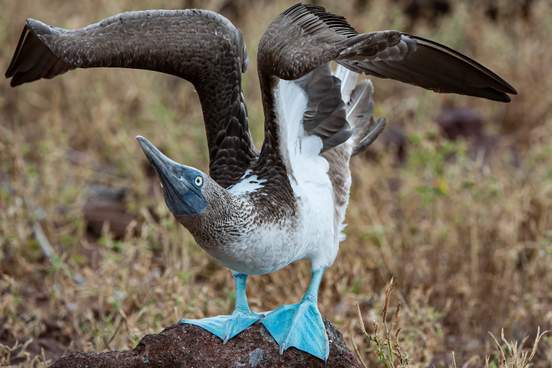
'Booby'
: any of several tropical seabirds (genus Sula) of the gannet family
Like buffle in bufflehead, booby is an old word for an awkward fool or dope that was later applied to a water-loving bird. Rude! This booby is an alteration of the Spanish bobo, which in turn came from the Latin adjective balbus, meaning “stammering.” There are many boobies—including masked boobies, red-footed boobies, and blue-footed boobies—all of which produce a number of sounds, from croaks to whistles. It should be noted, ahem, that the sometimes vulgar word for “breast” of the same spelling is etymologically distinct.
During nearly a quarter-century of tourism, this desert archipelago, home of rare and wonderful wildlife made legendary by Charles Darwin, has seen growth rates similar to Costa Rica’s. But visitation has generally been well managed, and it is still possible to encounter a blue-footed booby nesting right on the trail. Despite the fact that the annual limit of visitors is regularly exceeded, strict supervision, together with limited development of land-based facilities, has kept impact to a minimum.
— Ruth Norris, National Parks, Jan/Feb 1994

'Dickcissel'
: a common migratory black-throated finch (Spiza americana of the family Cardinalidae) of the central U.S.
Many of the bird names on this list, as you would expect, evolved from words completely devoid of offensive connotations while others—like dickcissel—are imitative, meant to represent the sounds made by our feathered friends. (You can read (and hear) more about words for bird calls and songs in this article.)
The dickcissel, a yellow-breasted songbird, winters in Venezuela, while the striking bobolink—males sport black and white feathers during the breeding season—journeys as far as Argentina, one of the longest migrations for a songbird.
— Emily Anthes, The New York Times, 29 Aug. 2023
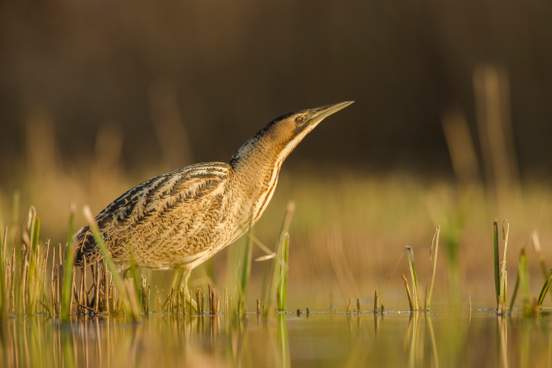
'Dunkadoo'
: a large North American marsh bird (Botaurus lentiginosus) that is related to the herons and has a brown body, dark gray outer wings, and a black stripe down each side of the neck
Dunkadoo, a dialectal name for the American bittern, is admittedly a bit milder of a potential put-down than, say, bushtit. American bitterns are secretive, somewhat husky marsh birds related to herons, and produce a distinctive call by repeatedly inflating their throats that some* have decided sounds like “dunk-a-doo,” hence the moniker. Other nicknames for the American bittern are just as fun to say (or call someone) include stake driver and thunder pumper, the latter of which is sometimes shortened to thunderpump.
* Clearly not including Henry William Herbert, as noted in the quote below.
“The bird, when fat, is considered by many to be excellent eating.”
It is on the strength of Mr. Wilson’s statement as above that I have given among the vulgar appellations of this beautiful bird that of Dunkadoo; though I must admit that I never heard him called a Dunkadoo, either on the sea-coast of New Jersey or any where else; and further must put it on record, that if the sea-coasters of New Jersey did coin the said melodious word as imitative of its common note, they proved much worse imitators than I have found them in whistling bay snipe, hawnking Canada geese, or yelping Brant. They might just as well have called him a Cockatoo, while they were about it.
— Henry William Herbert, American Game in Its Seasons (Charles Scribner, 1853)
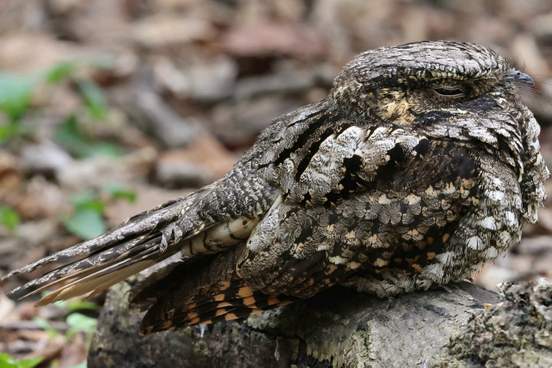
'Goatsucker'
: any of a family (Caprimulgidae) of medium-sized long-winged crepuscular or nocturnal birds (such as the whip-poor-wills and nighthawks) having a short bill, short legs, and soft mottled plumage and feeding on insects which they catch on the wing
Maybe it’s just us, but it’s difficult to look at a whip-poor-will, chuck-will’s-widow, or nighthawk and imagine them sucking milk from a goat. Yet at some point in history, people thought they did just that (we’re afraid to ask why—to each their own!). Nightjar is a more common, and less lactic, name for birds of the Caprimulgidae family, so called because of the tendency of their often hauntingly beautiful, nocturnal songs to “jar” people from sleep.
Many animals live upon insects; and this must have been the most difficult part of the provision to procure. There are nineteen species of goatsuckers; and there must have been in the ark two hundred and sixty-six individuals. These birds feed upon flies, moths, beetles, and other insects. What an innumerable multitude must have been provided for the goatsuckers alone!
— William Denton, The Deluge in the Light of Modern Science: A Discourse, (William Denton, 1869)
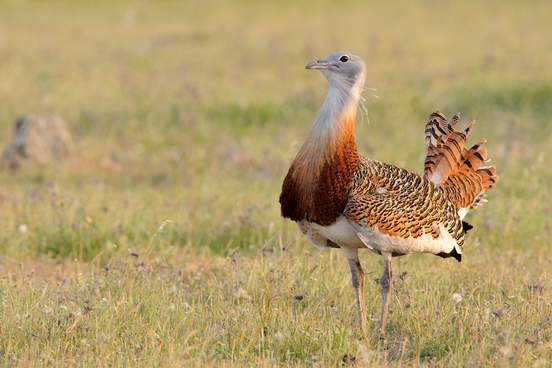
'Bustard'
: any of a family (Otididae) of large chiefly terrestrial Old World and Australian game birds
It’s probably clear by now that many of the names we use for birds are fairly unfair. Goatsuckers do not suck milk from goats, after all. Bustard is no exception, tracing all the way back (via Middle French and Old Italian) to the Latin avis tarda, meaning, literally “slow bird.” While it is true that bustards are a wee bit chonky compared to other birds, and are notable for the slow deliberate way in which they sometimes strut, these bustards are speedy runners and fliers.
“I suppose the genuine sea songs are always bawdy,” she said. “Probably that was why Ulysses made his sailors put wax in their ears while the sirens were chanting. Most lyric poetry is so beastly sentimental. It’s really only a biological gesture, a form of rut, ha-haugh! Like the wail of the tomcat or the nuptial dance of the bustard.” Dr. Chrisdie entered just then, raising his eyebrows; the purser hastened to pour sherry. He had planned his little group with care, so he was surprised when the three Men of Sin also appeared. They had a keen intuition for any sociability, and after their rehearsal they had followed Dr. Chrisdie. He dodged around various passageways, but they stuck to his trail; and Geoffrey followed theirs. “What’s a bustard?” asked Geoff, just as he looked cheerfully through the doorway. “Not me,” said Mr. Snead.
— Maxwell Struthers Burt, Along These Streets (Charles Scribner’s Sons, 1942)

'Bushtit'
: any of several very small, long-tailed birds (family Aegithalidae) that are related to the chickadees and titmice and are often found in large, active flocks; especially : a pale gray to pale brown bird (Psaltriparus minimus) of the Pacific coast from British Columbia to southern California and inland and southward to Wyoming, Texas, and Guatemala
The tit in bushtit is the same tit as in great tit, coal tit, bearded tit, marsh tit, bottle tit, and many, many, many more bird names. It’s also the same tit as in titmouse. In fact many of the diminutive bird species (at least the Eurasian ones) that feature tit prominently in the common names used to be referred to as some form or another of titmouse, before the word was shortened and reserved mostly for a few North American species, such as the tufted titmouse and oak titmouse. Titmouse itself is a combination of tit, a word once used to refer to many small things (unrelated to the vulgar slang for “teat”) and mose, an even older word for the birds. Looking at bushtits, it’s not difficult to see how they got their name—being similar in size and “cute” appearance to members of the family Paridae. However, taxonomists today place them in the family Aegithalidae, which makes them a little more distantly related to the “true” tits.
One day … near my house, I strained to see two bushtits on step one of the building process, the faintest spiderweb ring connecting two twigs. I got excited. The birds were doing something! Meanwhile, a ground squirrel crashed clumsily through the tree, and when it got too close to their fragile creation, the bushtits changed from their usual peeping to an alarm call. Unexpectedly caught up in this battle for existence in a small oak tree, I found myself wanting to join in the alarm and shoo the squirrel away.
— Jenny Odell, The Atlantic, June 2020
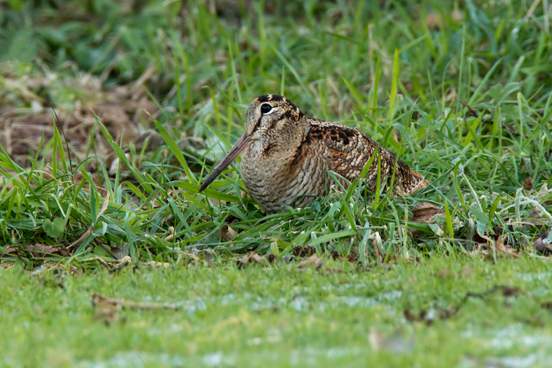
'Bogsucker'
: a shorebird chiefly of eastern North America that frequents moist woodlands and has large eyes and rounded wings
You know how the old song goes: “American woodcock / stay away from me / American woodcock / Mama let me be…” Just kidding of course, and besides—woodcocks are a delight to have around, from their goofy little struts (possibly to stir tasty worms below ground into revealing their presence) to their beautiful mating flight dances. We should all celebrate woodcocks, delight in woodcocks, sound our barbaric yawps over the roofs of the world about woodcocks—which is why it’s a bit odd, if amusing, that they are sometimes referred by the bluntest of sobriquets, bogsucker. At least if you don’t like bogsucker or even woodcock you’ve got a raft of other options (we are charmed in particular by timberdoodle and night-flit) …
… Pettingill writes that the woodcock has at least thirty-nine vernacular names, including (hold your breath) snipe, cock, little woodcock, less woodcock, timberdoodle, big-headed snipe, mud snipe, red-breasted snipe, blind snipe, big mud snipe, wood snipe, big snipe, brush snipe, thick-necked snipe, wall-eyed snipe, cane snipe, owl snipe, bar-capped snipe, whistling snipe, little whistler, whistler, Labrador twister, pewee, hill partridge, night-flit, night peck, woodhen, mudhen, bog sucker, bog bird, bog borer, marsh plover, holumpake, shrups, night becasse, and Massachusetts woodcock. He goes on to the list the names of the woodcock in Pennsylvania German, Chippewa, Canadian French, Creole, and German. Needless to say, there’s a lot of confusion around this bird.
— Greg Hoch, Sky Dance of the Woodcock: The Habits and Habitats of a Strange Little Bird (University of Iowa Press, 2019)

'Stank hen'
: an aquatic bird of the rail family that is widespread in the New World, Eurasia, and Africa and that has a red bill, red frontal area on the head, and a white band on the flanks
If you’ve ever been curious as to what it’s like to work for a dictionary, know that sometimes it involves clutching your sides for five minutes over stank hen. Stank is an old British term for a small dam or weir that dates back to Middle English and before that to Old French. Stank hen (and the also-funny variation stankie), naturally, arose in Scottish due to the bird’s habit of frequenting ponds. Nowadays, moorhen and gallinule are more widespread terms without the whiff of stank.
Will you take the trouble to ask of Dr David whether he knows of a bird called a Stank hen. It is a water foul less than a Duck with scolloped membranes at the toes but not close footed, and has a Crest on the forehead of the same kind of Substance with a cocks Comb but white & flat. It has a very fish taste and is found here in the loughs.
—Thomas Reid, personal correspondence (reprinted in The Correspondence of Thomas Reid, ed. Paul Wood, Pennsylvania State University Press, 2002), 17 Dec. 1766
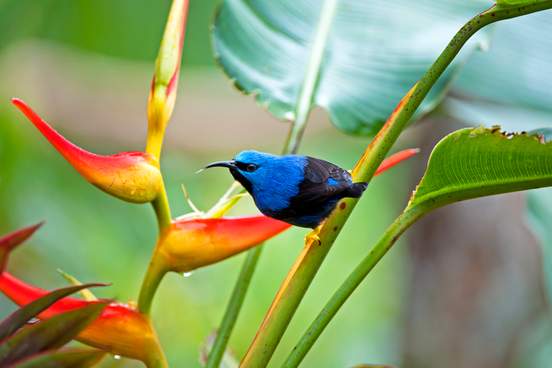
'Honeycreeper'
1 : any of numerous small bright-colored oscine birds (especially genera Cyanerpes and Chlorophanes of the family Coerebidae) of tropical America
2 : any of a family (Drepanididae) of often colorful oscine birds found only in Hawaii
Honeycreeper sounds like the perfect term for someone acting skeezy at the club, but for now it’s just the name for some truly lovely, colorful birds. Now that we think of it, maybe it should remain so—just because something sounds like an insult, doesn’t mean it is, or should be!
The diversifications of Darwin’s finches and Hawaiian honeycreepers are two text-book examples of adaptive radiation in birds. Why these two bird groups radiated while the remaining endemic birds in these two archipelagos exhibit relatively low diversity and disparity remains unexplained.
— Guillermo Navalón et al., Nature, 3 Feb. 2020





